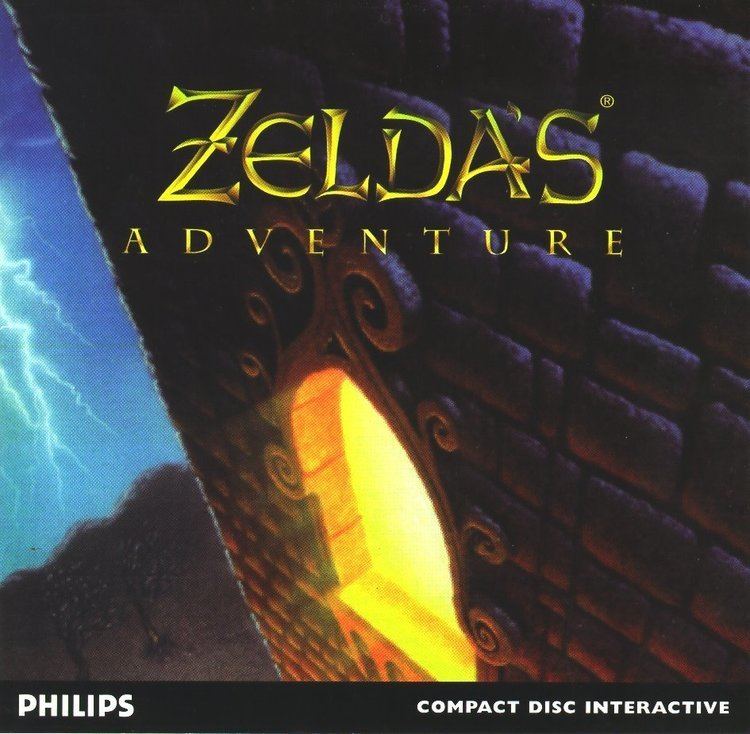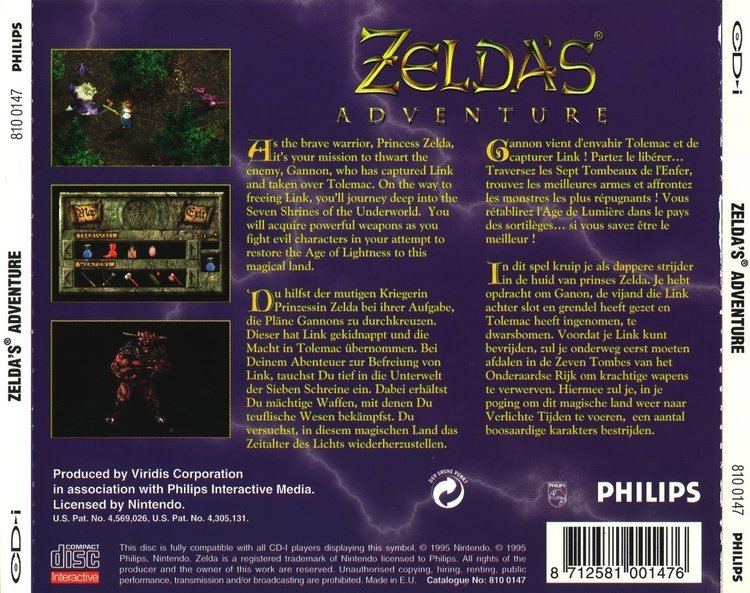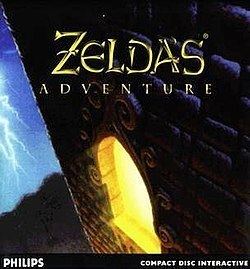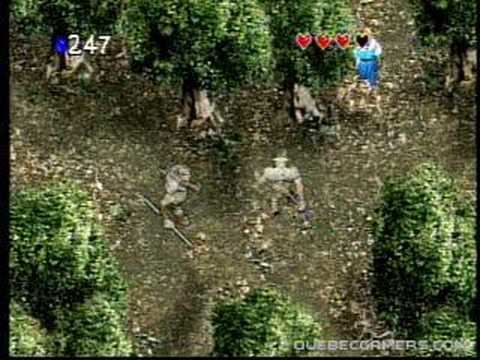9 /10 1 Votes9
Director(s) Anna Roth Initial release date 5 June 1994 | 4.5/5 Emuparadise Mode(s) Single-player Developer Viridis Genre Action-adventure game | |||||||||||||||||||||||||||||||||
 | ||||||||||||||||||||||||||||||||||
Designer(s) Lee BarnesChristopher Thompson Publishers Philips, Philips Interactive Media Similar The Legend of Zelda games, Action-adventure games | ||||||||||||||||||||||||||||||||||
Cd i part 3 faces of evil zelda s adventure angry video game nerd episode 61
Zelda's Adventure is an action-adventure fantasy video game developed by Viridis Corporation and released for the Philips CD-i console system. Set in the land of Tolemac, the game follows a non-traditional Zelda-saves-Link storyline, in which Link has been captured by the evil lord Ganon, and Zelda must collect the seven celestial signs in order to rescue him.
Contents
- Cd i part 3 faces of evil zelda s adventure angry video game nerd episode 61
- Zelda s adventure cdi pbg
- Gameplay
- Plot
- Development
- Reception
- References

Released nearly 8 months after the first two Zelda CD-i games, Zelda's Adventure uses a different game engine from Faces of Evil and Wand of Gamelon. Whereas the first two CD-i games were patterned on the side-scrolling Zelda II: The Adventure of Link, Zelda's Adventure took the top-down The Legend of Zelda, A Link to the Past, and Link's Awakening as its models. Zelda's Adventure is the only Legend of Zelda game to feature live-action cutscenes. Reception for the game was poor, and whereas some modern critics have given more nuanced reviews of the first two games, modern criticism for Zelda's Adventure is unanimously negative.

Zelda s adventure cdi pbg
Gameplay

Unlike the previous two CD-i Zelda games, which take the side-scrolling view from Zelda II, Zelda's Adventure is played with the overhead view found in The Legend of Zelda. Playing as Princess Zelda, the aim is to fight through the Seven Shrines of the Underworld to collect the celestial signs, and bring the land of Tolemac to an Age of Lightness.
Unlike the other two games, Zelda's Adventure was created by Viridis, an entirely different company, with a change in style and gameplay. Level design is very much like the original The Legend of Zelda and The Legend of Zelda: A Link to the Past, with an overworld that allows access to individual dungeons. The FMV sequences that present the plot are live action instead of animated.
Plot
Ganon has kidnapped Link and stolen the seven celestial signs, creating an "Age of Darkness" in the kingdom of Tolemac. Princess Zelda is recruited by the court astrologer Gaspra (played by Mark Andrade) to collect the signs to defeat Ganon and save Link.
Guided by the words of Shurmak, Zelda must first travel through the forest to the Shrine of Rock, where she encounters Llort, a greedy minion of Ganon who protects the first celestial sign. Gaspra appears to congratulate Zelda and direct her to the Shrine of Illusion where she faces Pasquinade to earn the second celestial sign. Guided by the inhabitants of Tolemac, Zelda then makes her way to the mountains to conquer the Shrines of Air and Destiny before crossing the great south sea to challenge Agwanda at the Shrine of Water for the fifth sign. Gaspra directs Zelda once more to the Shrine of Power in the southeast where her strength is tested, before travelling to the Shrine of Fire where she will face Warbane. As Zelda reaches to collect the final celestial sign Ganon's claw stops her, and she is drawn into his lair for the final battle.
In the game's final scenes, peace returns to Tolemac. Link is revealed to be safe, holding hands with Zelda where the entrance to Ganon's lair once stood, the land now thriving with new growth.
Development
In 1989, Nintendo signed a deal with Sony to begin development of a CD-ROM-based system known as the "Nintendo PlayStation" or the SNES CD to be an add-on to the Super Nintendo Entertainment System that would allow for FMV and larger games. However, Nintendo broke the agreement and instead signed with Philips to make the add-on, which caused Sony to spin off their add-on into its own console called the PlayStation. Witnessing the poor reception of the Sega Mega-CD, Nintendo scrapped the idea of making an add-on entirely. As part of dissolving the agreement with Philips, Nintendo gave them the license to use five of their characters, including Link, Princess Zelda, and Ganon, for games on Philips's console called the CD-i, after the partnership's dissolution. Contracting out to independent studios, Philips subsequently used the characters to create three games for the CD-i, with Nintendo taking no part in their development except to give input on the look of the characters based on the artwork from Nintendo's original two titles and that of their respective instruction booklets. Philips insisted that the development studios utilize all aspects of the CD-i's capabilities including FMV, high-resolution graphics, and CD-quality music. Because the system had not been designed as a dedicated video game console, there were several technical limitations, such as laggy controls (especially for the standard infrared controller), and numerous problems in streaming-audio, memory, disc access, and graphics.
The backgrounds for Zelda's Adventure were created from videos of scenery near Santa Monica Boulevard in West L.A., footage of Hawaii taken from a helicopter, and the developers' vacation photos. This decision was responsible for much of the game's RAM usage, causing backgrounds to scroll slowly and causing extreme frustration to the game's developers. The CD-i's technical abilities were so limited that the use of one or two kilobytes of system RAM caused arguments amongst the developers. Photos of the characters were shot using mirrors mounted on the ceiling, which was so low it precluded mounting the camera. The composer for Zelda's Adventure also played the part of Gaspra in the game's cutscenes. The houses and interiors built for the cut scenes were built as scale models. The model artist was Jason Bakutis, who had worked in Hollywood on movies like Critters 3 and Freddy's Dead: The Final Nightmare. Developers have stated they were not influenced by the first two CD-i Zelda games. Zelda's Adventure spent two years in testing, longer than it took to develop the game. Much more music was composed for the game than was used. Developers had difficulty making sure all the areas of the game had proper background masking. There were plans at one point to hire Echo & the Bunnymen to do the music.
Intending to push the capacities of the CD-i to its limits, development initially progressed with a goal of 600 screens and 160 NPCs. At this early stage, Viridis president Lee Barnes suggested that playthrough time might take as much as 300 hours. These development figures were reduced in the final product which had only a handful of NPCs and whose playthrough time has been placed by one commentator at only 12 hours.
The majority of the game's programming was done by one person - Randy Casey. Randy was responsible for programming all of the game and all associated tools. Additional programming for the inventory system and game progress tracking, dubbed "FRP engine" was done by Gavin James. There is conflicting information about the game's budget—one developer claims there was "no budget at all" while Bakutis claims (possibly facetiously) it had "the biggest budget ever for a video game".
Reception
Like the other two CD-i Zelda games, Zelda's Adventure was widely panned by critics. The graphics of Zelda's Adventure were called "blurry and digitized". Wired magazine said that the graphics were some of the worst ever encountered. The game's acting was criticized as unprofessional. Another flaw that has been identified is that the game could not produce both sound effects and music at the same time. Scott Sharkey of 1UP.com called the box art of Zelda's Adventure one of the 15 worst ever made. Zelda's Adventure was released as the Philips CD-i was being discontinued and has become very rare over time, as have the first two Philips Zelda games; Zelda's Adventure is regularly sold for over $100. Zelda's Adventure appeared in a bracket poll of "The Greatest Legend of Zelda Game" along with Zelda: The Wand of Gamelon. It lost in the first set of rounds to The Legend of Zelda: Ocarina of Time.
Despite giving positive reviews for Faces of Evil and Wand of Gamelon neither Danny Cowan of 1UP.com nor RetroGamer's John Szczepaniak would extend them to Zelda's Adventure, which Szczepaniak described as demonstrating arbitrary and illogical design, sloppy visuals, nearly non-existent music, excruciatingly high difficulty and cumbersome loading and controlling. Gameplay for Zelda's Adventure has also been portrayed as a trial-and-error effort to guess which items can be used to defeat which enemy. Cowan called Zelda's Adventure "practically unplayable" due to the jerky frame rate, unresponsive controls and long load times, summarizing his review with a warning to "avoid this game at all costs." In discussing the popular online conception that Zelda's Adventure is superior to Wand of Gamelon and Faces of Evil, RetroGamer pointed to the top-down perspective as fomenting misinformation regarding the game's similarities to the original Zelda when, according to RetroGamer, the game is actually not worth playing.
